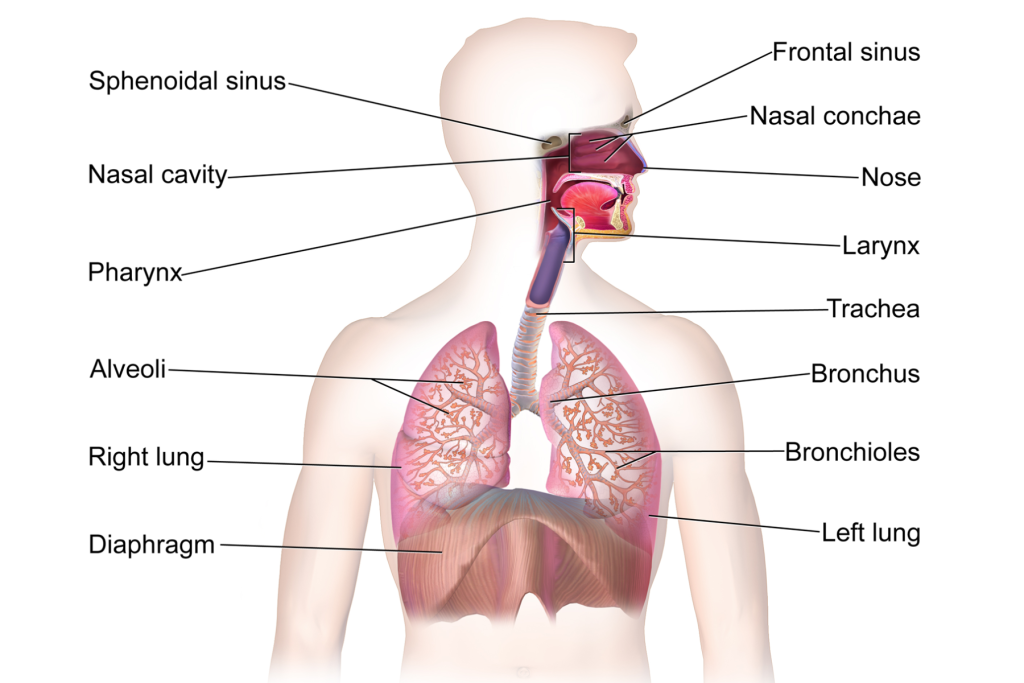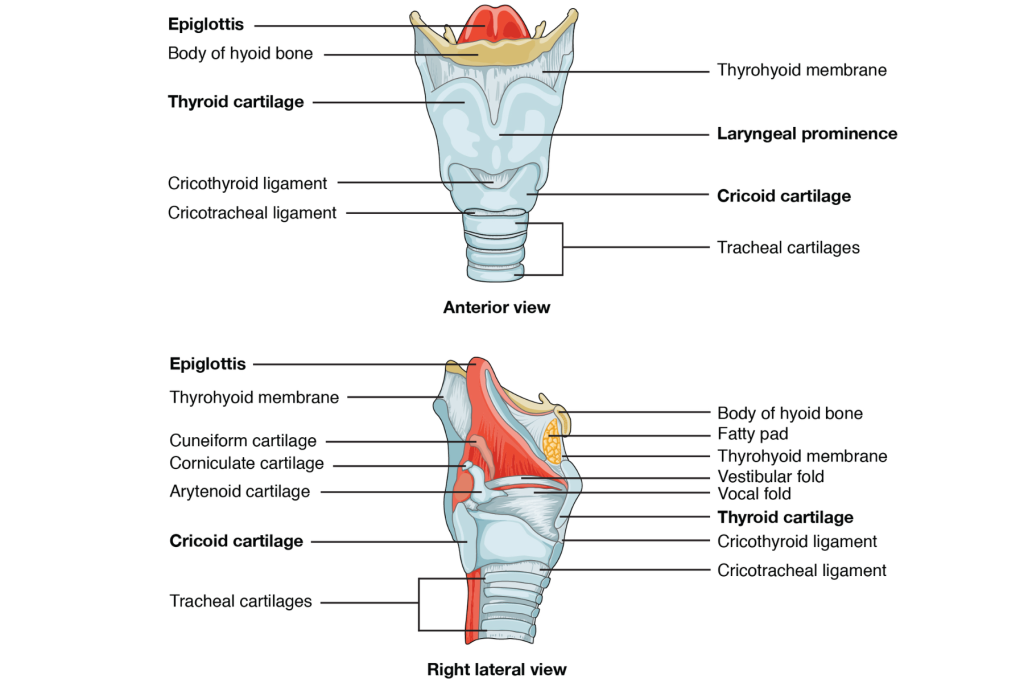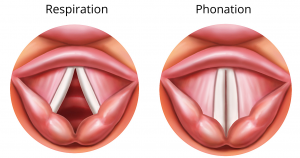
Did you know that our vocal cords vibrate more than 100 times per second when we produce voiced sounds?
Humming, speaking and singing are actions that may seem trivial, but they involve the coordination of multiple anatomical structures belonging to the respiratory and phonatory systems. This post provides an overview of these systems and the mechanisms that allow us to produce voice.
The respiratory system provides the air needed to produce sounds. Breathing is divided into two phases: inspiration and expiration. The voice is produced during the exhalation phase. During this phase, the diaphragm (a large muscle located at the base of the lungs), and the intercostal muscles (located between the ribs) are relaxed, and the volume of the rib cage and lungs decreases. This decrease in volume increases the pressure inside the lungs, which pushes the air out. The air then flows out of the lungs and passes through the trachea, larynx, pharynx, mouth and nose (see figure 1).

Figure 1. Illustration of anatomical structures of the respiratory and phonatory systems (The respiratory system) by BruceBlaus under license CC BY 3.0.
During exhalation, the passage of air through the larynx allows the vocal folds (also called vocal cords) to vibrate. The larynx and the vocal folds are part of the phonatory system. The larynx is located in the throat above the trachea (see figure 1). It is made up of cartilage, ligaments, and several muscles. Figure 2 shows the outside of the larynx from the front (anterior view), as well as the inside of the larynx seen from the side (right lateral view). The cartilages and certain ligaments are illustrated on that figure. Among the visible structures, you may be familiar with the epiglottis, mainly formed of cartilage, which tilts in order to protect the respiratory tract when eating or drinking. Another well-known structure is the laryngeal prominence, commonly called “Adam’s apple”. Adam’s apple is more visible in men since the thyroid cartilage is larger than in women.

Figure 2. Illustration of the larynx (The Larynx) by OpenStax College under license CC BY 3.0.
In figure 2, the right lateral view also shows the horizontal positioning of the vocal folds, which cross the larynx. The term “vocal folds” is more accurate than the more widespread term “vocal cord”, since they are not cords, but rather folds, as can be seen in figure 3, where the vocal folds are viewed from above, inside the larynx.

Figure 3. Illustration of vocal folds, adapted from the original image (Vocalcordparalyses) by Prejun under license CC0 1.0. The image on the left illustrates the positioning of the vocal folds during breathing. The image on the right illustrates their closure during phonation, i.e., during voice production.
When breathing, the vocal folds are semi-open. When we produce voiced sounds, they are rather in a closed position, thanks to the contraction of certain muscles. This closure, combined with the air pressure from the lungs, cause them to vibrate, which produces voiced sounds, which is the basic sound produced by vocal fold vibration. The vocal folds vibrate rapidly: more than 100 times per second! The frequency of vibration is generally higher in children and women than in men, which makes their voices higher pitched. Their vocal folds vibrate more quickly, because their mass is smaller, and they are shorter. With age, the larynx widens, and the vocal folds lengthen leading to voice changes. Although each person has a specific voice pitch, pitch and intensity can be modulated by altering the tension and lengthening of the vocal folds. Indeed, the cartilages of the larynx, to which the vocal folds are attached, are articulated and can move with the contraction of several muscles (you can actually feel the movements of your larynx by touching the front of your neck, while by producing the sound /a/ more or less high-pitched). For example, the arytenoid cartilages (see Figure 2) can rotate, tilt or glide, depending on which muscles are contracted. These movements can increase the tension of the vocal folds and thus make the voice higher or decrease their tension and make the voice lower. The movement of the vocal folds can be observed using an endoscope, that is, a medical instrument inserted through the mouth or nose, equipped with a camera and a stroboscope. The stroboscope reveals the movement of the vocal folds in slow motion, as you can see in the video below:
By increasing the medial compression of the vocal folds (i.e., closing the vocal folds more tightly, by bringing the arytenoid cartilages together) and increasing the amount of exhaled air, we can produce a louder voice.
And what happens when we whisper? The vocal folds are partially closed, and they do not vibrate. The whispered voice, unlike the normal voice, is caused by turbulence generated by air friction in and above the larynx.
Our voice is also influenced by the resonators or resonance chambers (pharynx and the oral and nasal cavities). Indeed, after passing through the larynx, the air goes into the pharynx and the oral and nasal cavities (see figure 1). These cavities form resonance chambers, which amplify certain sounds and also transform them. The size and shape of the resonance chambers influence voice timbre.
Thus, although the vocal folds play a key role in voice production, several other organs make it possible to produce and modulate the voice and give it its particular sound characteristics!
Further readings:



